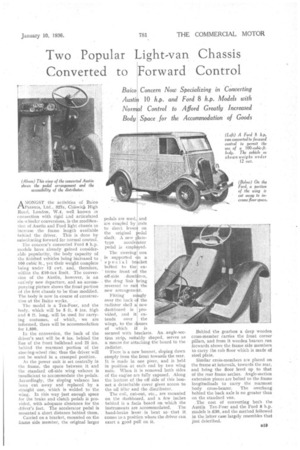Two Popular Light-van Chassis
Page 37

If you've noticed an error in this article please click here to report it so we can fix it.
Converted to Forward Control
Baico Austi Nor Body
Concern Now Specializing in Converting 10 h.p. and Ford 8 h.p. Models with I Control to Afford Greatly Increased Space for the Accommodation of Goods AMONGST the activities. of Baico Patents, Ltd., 327a, Chiswick High Road, London, W.4, well known an connection with rigid and articulated six-wheeler conversions, is the modification of Austin and Ford light chassis to increase the frame length available behind the driver. This is done by substituting forward for normal control.
The concern's converted Ford 8 h.p. models have already gained considerable popularity, the body capacity of the finished vehicles being increased to 100 cubiO ft., yet their weight complete being under 12 cwt. and, therefore, within the £10-tax limit. The Conversion of the Aiastin, however, is an entirely new departure, and an accompanying picture shows the front portion of the first chassis to be thus modified. The body is now in course of construc tion at the Bait() works. .
The model is a Ten-Four, and the body, which will be 5 ft. 6 ins, high and 8 ft. long, will be used for carrying costumes, of which, we are informed, there will be accommodation for 1,500.
In the conversion, the back of the driver's seat will be 6 ins, behind the line of the front bulkhead and 21 ins, behind the rearmost portion of the steering-wheel rim; thus the driver will not be seated in a cramped position.
As the power unit is set centrally in the frame, the space between it and the standard off-side wing valance is insufficient to accommodate the pedals. Accordingly, the sloping valance has been cut away and replaced by a straight one, which is welded to the wing. In this way just enough space for the brake and clutch pedals is provided, with adequate clearance for the driver's feet. • The accelerator pedal is mounted a short distance behind them.
Carried on a bracket, mounted on the frame side member, the original larger pedals are used, and are coupled by rods to short levers on the original pedal shalt. A new plate type accelerator pedal is employed.
The steering box is supported on a • special bracket bolted to the extreme front • of the off-side dumbiron, the drag link being reversed to suit the new arrangement.
Fitting snugly over the hack of the radiator shell a new dashboard is provided, and it extends over the wings, to the domes of which it is secured with brackets. An., angle-section strip, suitably shaped, serves as a means for attaching the board to the radiator.
There is a new bonnet, sloping down steeply from the front towards the rear. It is made in one piece, and is held in position at each end by two wing nuts. When it is removed both sides of the engine are fully exposed. Along the bottom of the off side of this bonnet a detachable cover gives access to the oil filler and the distributor.
The coil, cut-out, etc., are mounted on the dashboard, and a few inches behind is a facia board on which the instruments are .accommodated. The hand-brake lever, is bent so • that it comes to a position where .the driver can exert a good pull on it, • Behind the gearbox a deep wooden cross-member carries the front corner pillars, and from it wooden bearers run forwards above the frame side members to carry the cab floor which is made of steel plate.
Similar cro'Ss-members are placed on the frame at intervals, towards the rear, and bring the floor level up to that of the rear frame arches, Angle-section extension pieces are bolted to the frame longitudinals to carry the rearmost body cross-bearer. The overhang behind the back axle is no greater than on the standard van.
The cost of converting both the Austin Ten-Four and the Ford 8 h.p. models is £30, and the method followed in the latter case largely resembles that just deScribed.




































































































